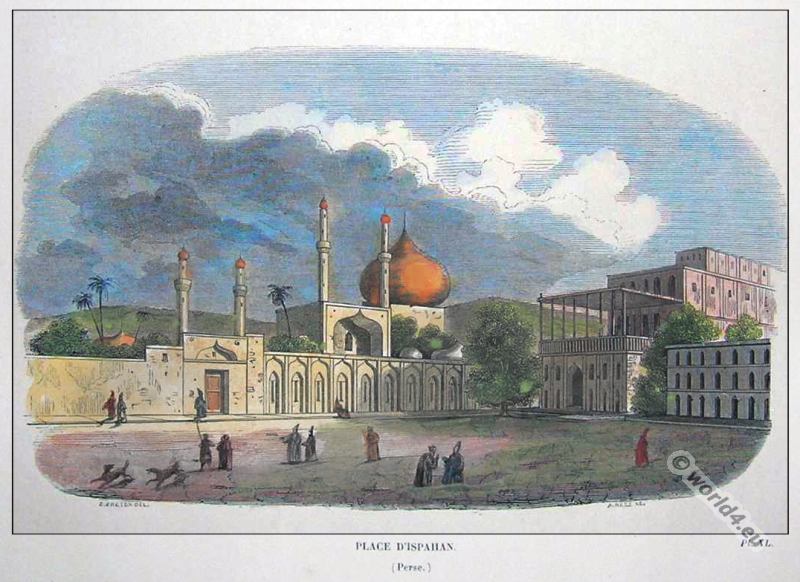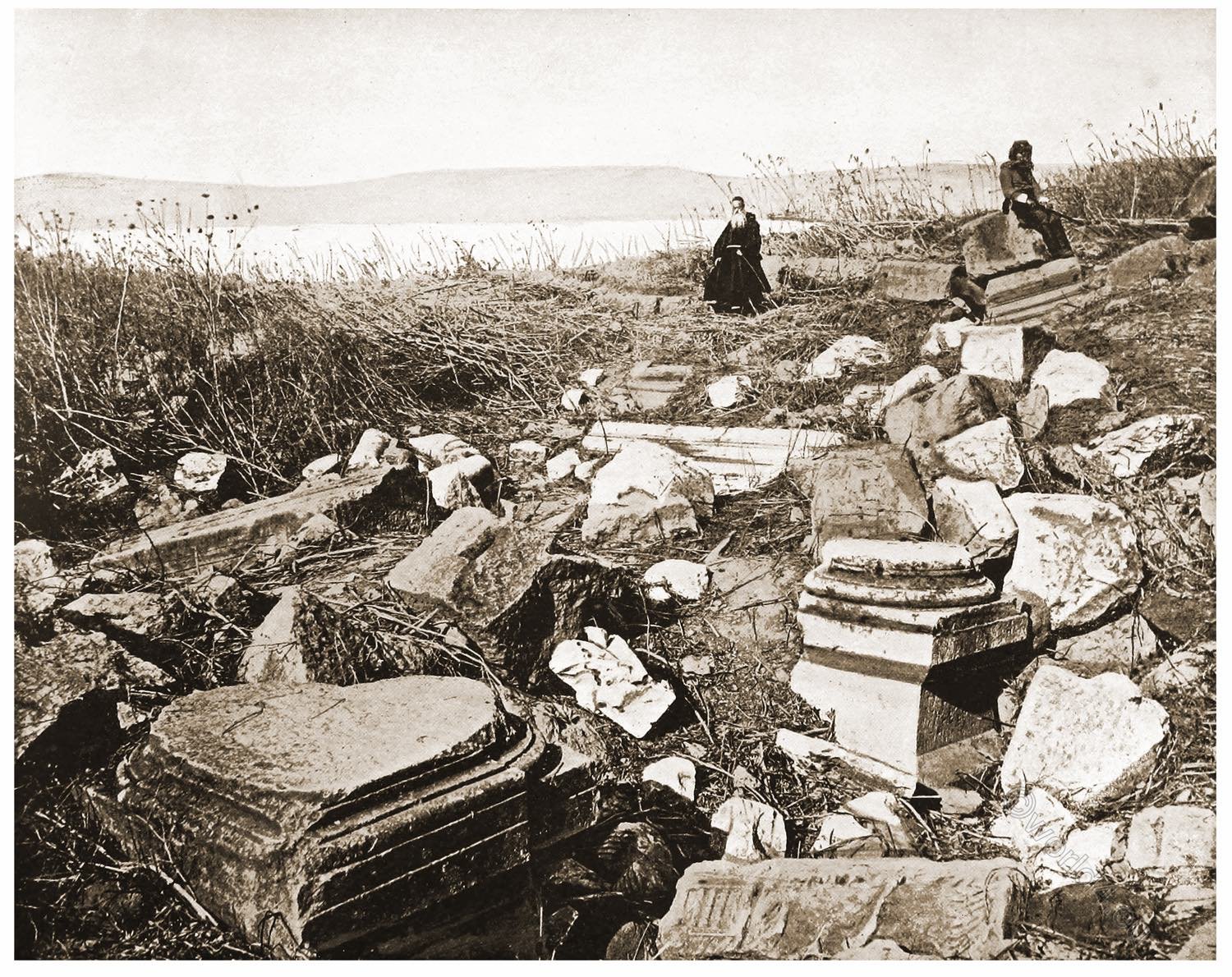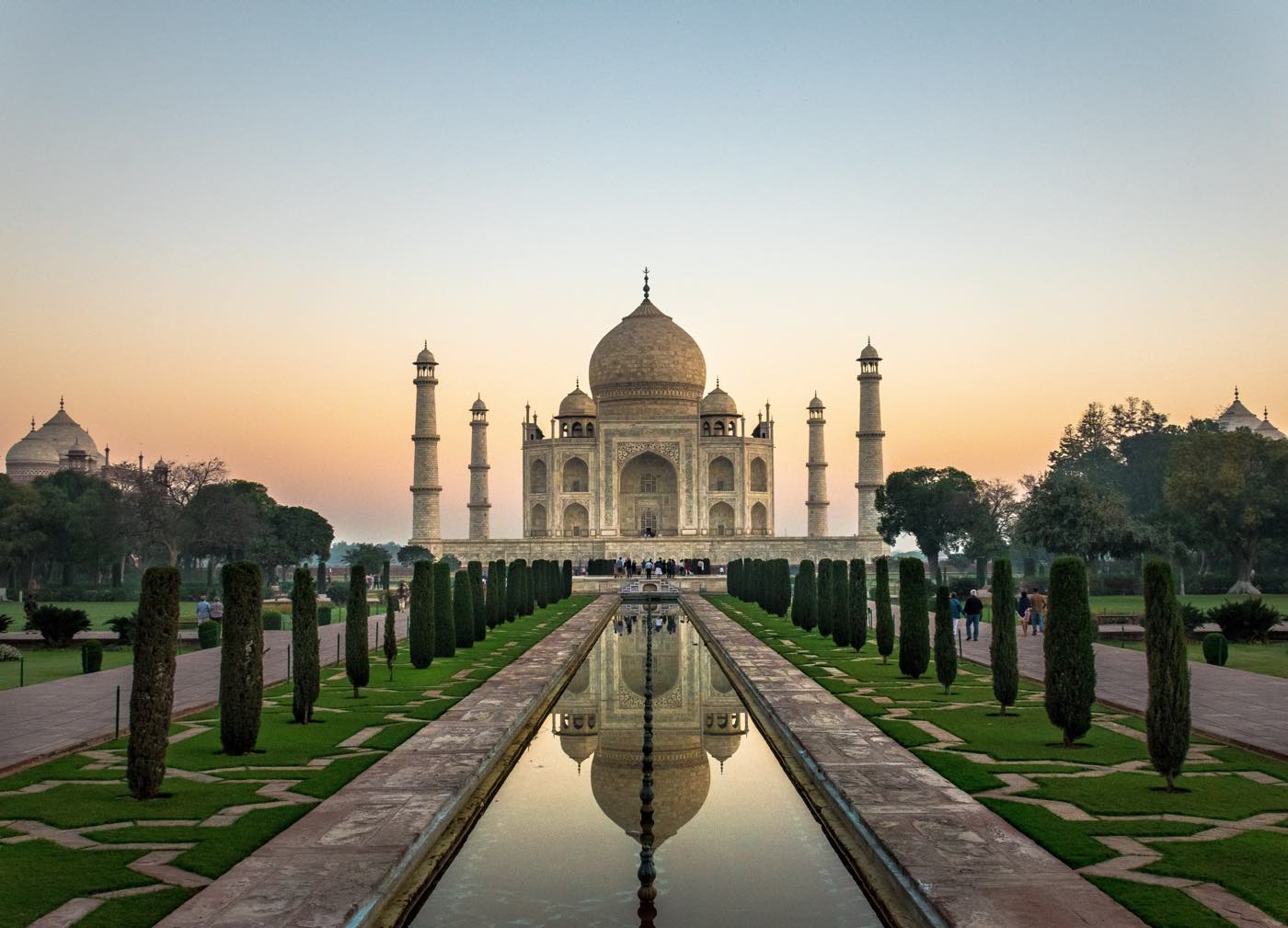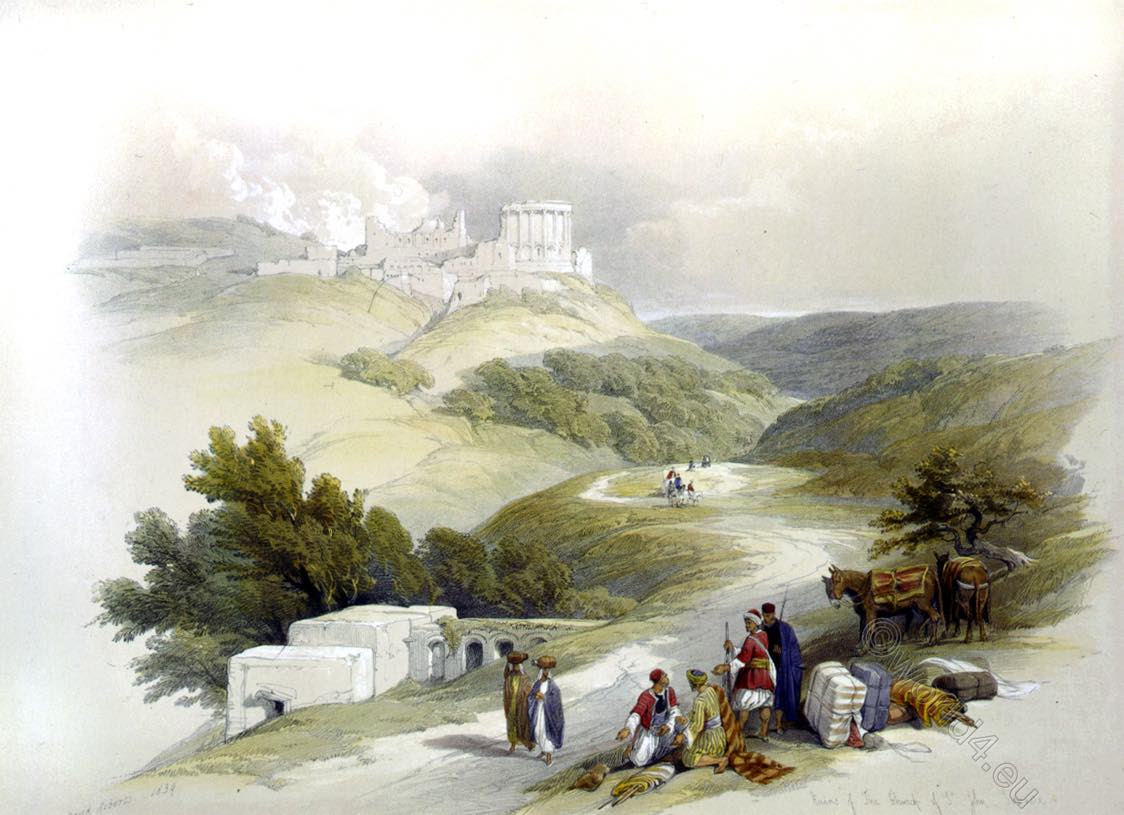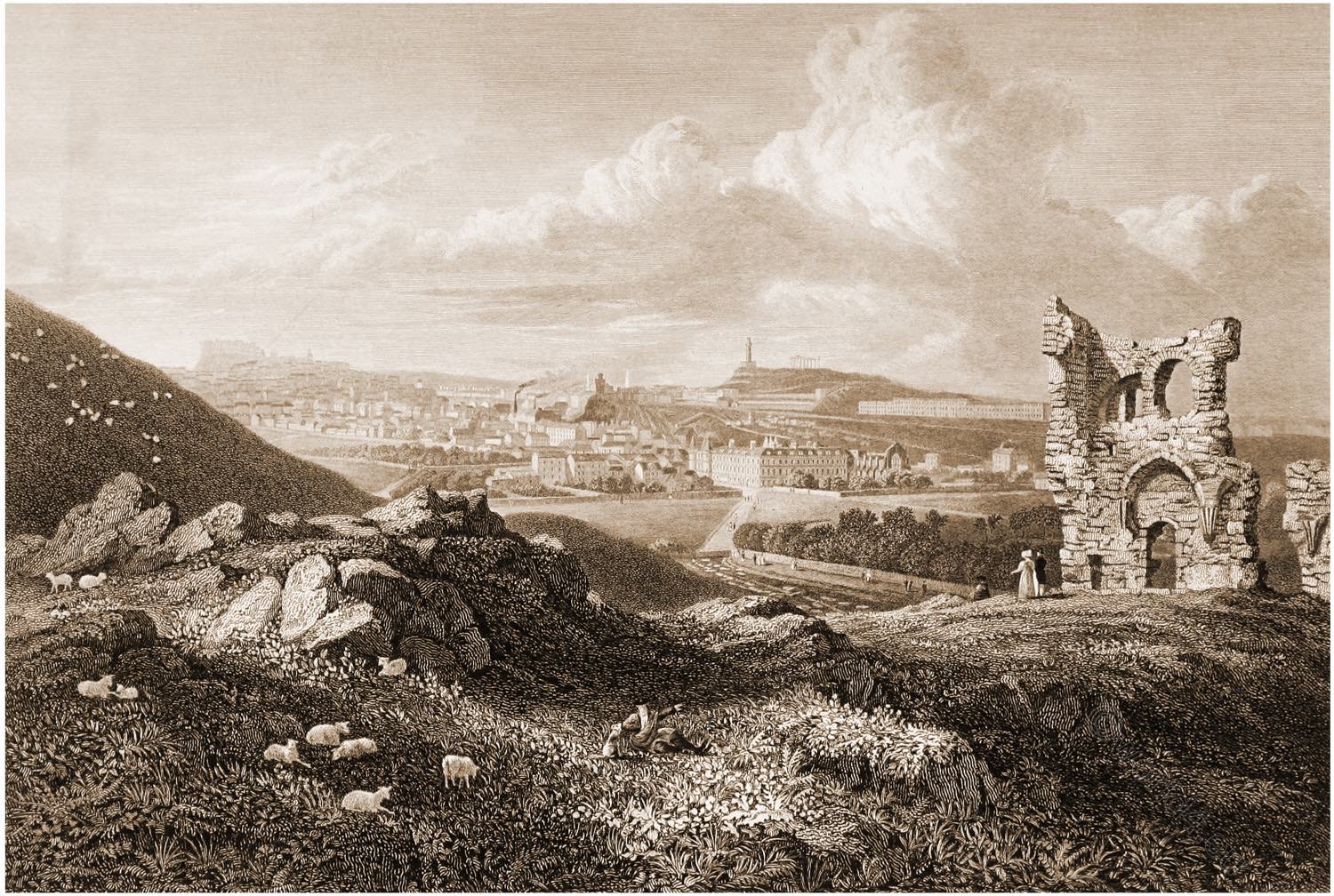Ruins about the Taj Mahal, Agra.
The former extent and splendor of the city of Agra may be traced by the number of the ruins which spread themselves around upon every side. Vast tracts covered with old buildings, the remains of weds, and fragments of walls, which originally flourished in the midst of verdure, and under the shade of forest trees, now only render the wide waste of sand, which has swallowed up all vegetation, still more desolate.
The country between the fort of Agra and the Taj Mahal is a perfect desert; and visitors, after winding their way through an arid plain, only diversified by sand-heaps and crumbling masses of stone, come, as if by enchantment, upon the luxuriant gardens which still adorn the mausoleum where Shah Jahan and the beautiful partner of his throne Mumtaz Mahal sleep in undisturbed repose.
The marble cupola seen to the left of the plate, crowns a beautiful musjid or mosque, attached to the Taj Mahal; beyond, flanked by its slender minars, the Taj itself appears; and in the distance the eye rests upon the cupolas and turrets of the magnificent gateway which forms the principal entrance of this terrestrial paradise.
Constant irrigation is necessary in India, to preserve the beauty of gardens, which soon disappears if not continually refreshed by the revivifying stream. The pleasure-grounds belonging to the Taj Mahal are watered daily during the dry season; and they are clothed in perpetual verdure, while the surrounding country is a wilderness.
The arched gateway represented in the plate,leads into an enclosure of considerable extent, intervening between the plain and the gardens of the Taj. Many buddings of the same nature skirt these beautiful gardens, and some have been fitted up for the residences of European families during the rains, the only season in which native habitations, however splendid, can be easily converted into comfortable abodes for strangers,from a colder country; it being both difficult to exclude the hot winds, and to warm chambers,open to every breath of heaven,sufficiently during the cold weather.
The natives themselves are content to envelop their persons in thick clothing; the men wear several shawls, and the women put on wadded garments and extra veils, during a period in which the English residents shut up their doors and windows and sit around fires.
The superior elegance of the native architecture renders it a subject for regret that so few of the deserted buildings, in the neighborhood of British cantonments, should have been adapted to the use of the new-comers: one or two of the mosques and tombs of Agra have been fitted up for the reception of the families of resident civilians; but the greater number of the European population are lodged in excessively ugly bungalows, built with the old bricks which cover miles of the suburbs of Agra, and which may be had for the trouble of fetching them.
A few of the newly-constructed houses are in better taste, after the Italian manner; but these occur too seldom to atone for the frightful and barn like appearance of the rest. The gardens attached to these houses, though large,luxuriant, and well planted, are too much isolated from them to improve their general aspect; and the only attempt to beautify the tract exclusively occupied by military residents in the close neighborhood of the Taj Mahal, has been made by the introduction of Parkinsonias (Parkinsonia aculeata, pea family, Fabaceae).
These trees, originally imported from the Cape by Colonel Parkinson, thrive wed, with very little attention, in the most arid spots. When mingled with others, they would be very attractive, but their leaves being entirely obscured by an abundance of bright yellow flowers, their effect, when scattered singly over a sandy plain, is any thing rather than pleasing. The court and council of the new presidency will find much to do upon their arrival at Agra, and there is fortunately abundance of material for the exercise of taste and talent.
The church belonging to the cantonments is a very handsome structure, built under the superintendence of an officer of engineers. Several excellent architects are to be found in this department of the service, and Agra is much indebted to the gentleman who has held an appointment for some years in the board of works at that station, for the improvements which he has introduced into the interiors of the bungalows built under his direction.
The necessity of consulting economy, and of excluding the heat, have exceedingly injured the outward appearance of Anglo-Indian residences in the province; but though, at Agra, both the brick and the enteha houses (the name given to those constructed of unbaked mud) are miracles of ugliness, many of the interiors are finished with great elegance. The best boast of chimney-pieces of marble chunam, and the walls are decorated with mouldings and cornices, which take away from the bleak and desolate air usually the characteristics of these unsophisticated edifices. A great deal, however, still remains to be done; and although military residents have not very extensive funds at their disposal, should a spirit of emulation be created amongst them, they will at least plant out what it may be impossible to pull down and rebuild, and thus render the cantonments of Agra more worthy of their beautiful neighbour, the Taj Mahal.
Source: Hindostan; its landscapes, palaces, temples, tombs; the shores of the Red Sea; and the scenery of the Himalaya Mountains, illustrated in a series of views. With descriptions by Emma Roberts. London 1850.
Related
Discover more from World4 Costume Culture History
Subscribe to get the latest posts sent to your email.



